Consideration of Complexity in the Management of Construction and Demolition Waste Flow in French Regions: An Agent-Based Computational Economics Approach
Abstract
:1. Introduction
1.1. Planning and Managing Waste in a Region in France: A Complex System
- (Q0—demand) What is the annual renovation rate of roads in the region?
- (Q1—supply) What are the material needs for gravel, natural aggregates, and asphalt?
- (Q2—territorial foresight) How might the situation change over time?
1.2. Purpose of This Paper
2. Materials and Methods
2.1. Boundaries of the Work and Reasons
- Recycling: for road renovation, road construction, concrete design mixes using recycled aggregates [11], etc.
- Valorization: for reuse on the same demolition place, quarry backfill, etc.
- Storage: for example, in the inert waste storage or ISDI (Installation et Stockage des Déchets Inertes)
2.2. State of the Art
2.2.1. The Previous Situations in the PACA Region
2.2.2. Beyond PACA: The BTP Sector in General
2.3. Proposal
2.3.1. Refinement of the Question
2.3.2. Methodology Proposal
2.3.3. The Complexity Paradigms
- the analytical paradigm
- the restricted complexity paradigm
- the generalised complexity paradigm
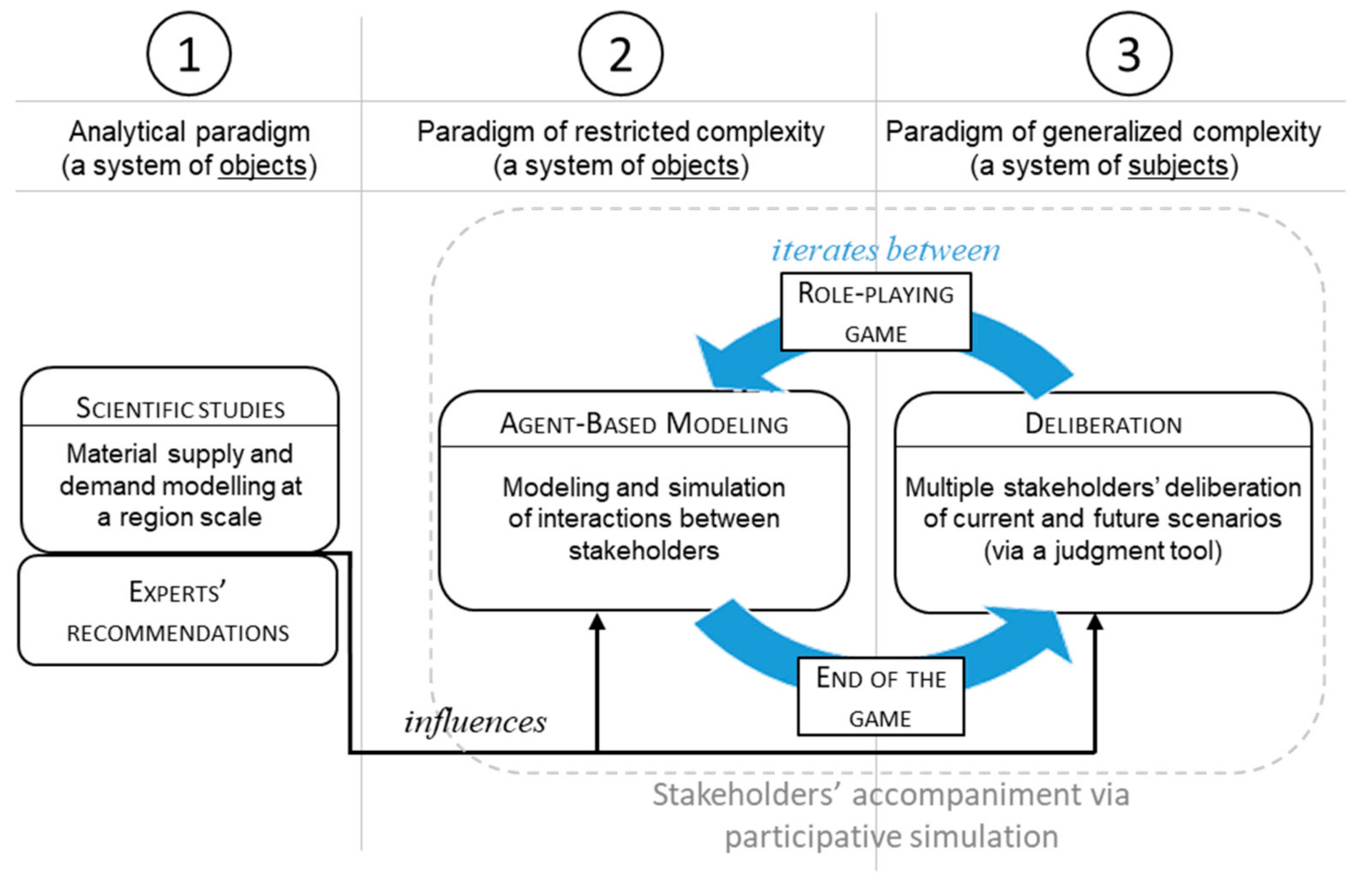
2.4. Model Description
2.4.1. List of Decision-Making Entities
2.4.2. Interaction Sequences
2.4.3. Model Data Source and Evaluation
2.4.4. Simulation Platform
2.5. Sensitivity Analysis
- (a) search radius of suppliers and (b) production rates at sites that did not respond to the 2015 survey;
- Regarding the outputs: (i) regional production difference in material between the actual global value for 2015 (Table 1) and the value from the simulation, and (ii) distribution of renovation rate.The first output aims to validate the model and the second aims to use the model thematically.The plan covers the following experiments:
- Varying the search radius between 0 and 170 km in 5 km steps. In France, materials will not generally be transported more than 170 km [18].
- For the production rate of sites that did not respond to the survey, entering first 100% (the default scenario: maximum production), then 70%. The 70% in the figure does not correspond to any field need. It is purely hypothetical and used to test the model’s sensitivity if the production were 30% less than the default value of 100% obtained via POM.
3. Results
- below 0.01% → white
- 0.01% → light grey
- 25% → black
- between 0.01% and 25 % → gradual variation between light grey and black
- above 25% → blue
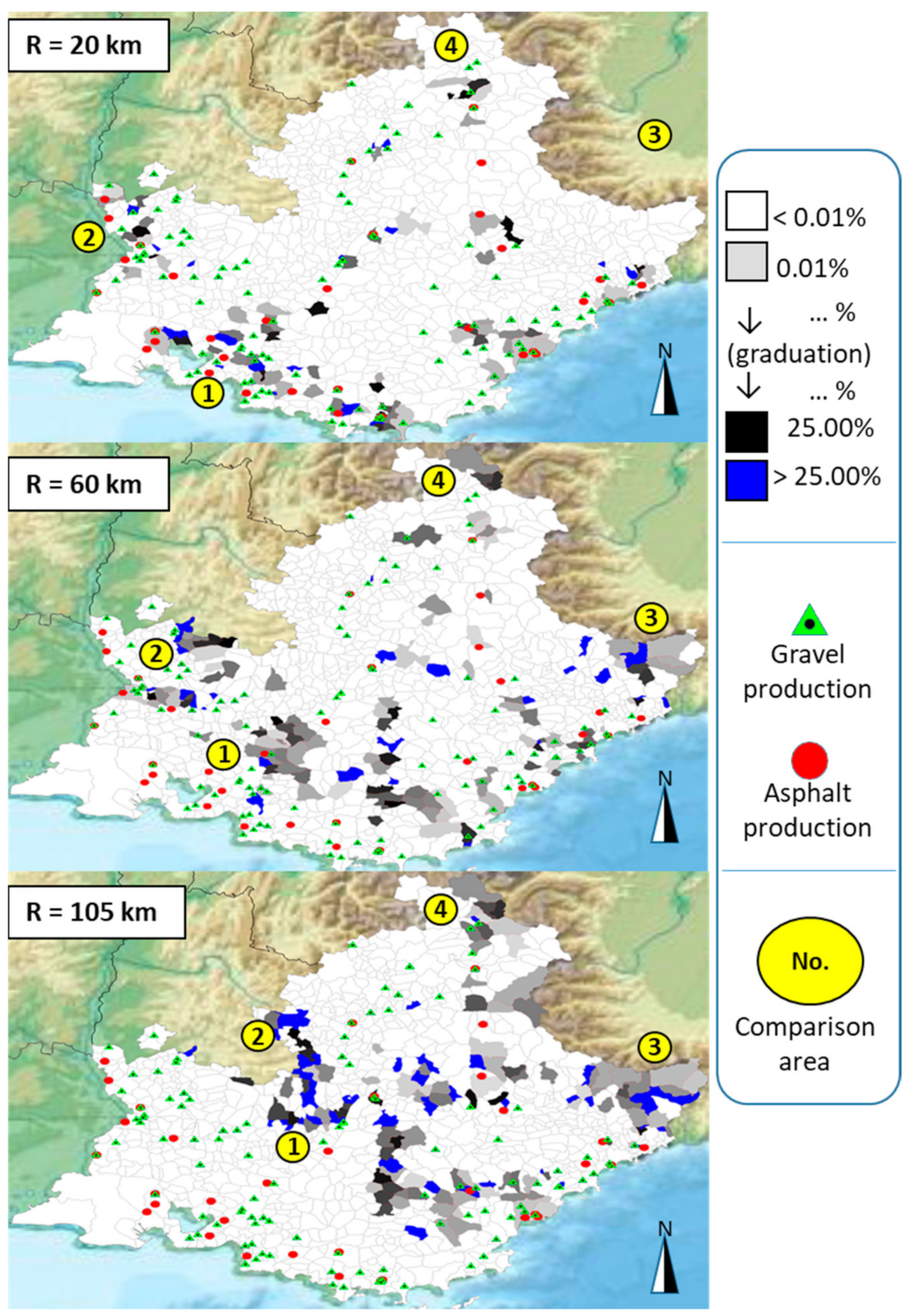
4. Discussion
4.1. Contribution/Limitation of the Work Regarding Waste Flow Modelling in PACA
4.2. Regarding the Acceptance of Complexity
- Continuing communication in regard to the interest in the approach to the BTP sector, but supporting its usefulness with arguments uniquely when this proves to be necessary.
- Reinforcing the coupling of ACE with the conventional approach, instead of model development in a purely agent framework. This would enable the sector to be more easily convinced that the ACE approach is complementary and not competitive [49]. This would increase the chances of it interesting them.
- When the application so requires, systematic use of maps of geological and/or urban mine extraction areas of these resources (if they are available) during simulations. In fact, in the geosciences field, maps constitute one of the most important decision aids [54,55]. It is thus incumbent on ACE simulation, for better acceptance of its usefulness, to justify its added value in enriching the thematic content of maps (and not the opposite).
- Systematic communication of the machine time of the simulations carried out, to enable entities not specialised in ACE to understand the real performance of this type of method and to correct preconceived ideas (e.g.,: a simulation which could last a week, etc.).
4.3. How Can the PACA Region Results Be Transposed to Ile-de-France
5. Conclusions
Perspectives
Supplementary Materials
Author Contributions
Funding
Institutional Review Board Statement
Informed Consent Statement
Data Availability Statement
Acknowledgments
Conflicts of Interest
References
- LOI n° 2015-991 du 7 Août 2015 Related to the Reorganization of French Republic territories. Available online: https://www.legifrance.gouv.fr/eli/loi/2015/8/7/2015-991/jo/texte (accessed on 1 December 2019). (In French).
- Décret n° 2016-811 du 17 Juin 2016 Related to the Regional Prevention and Management Plan for Waste. Available online: https://www.legifrance.gouv.fr/eli/decret/2016/6/17/2016-811/jo/texte (accessed on 1 December 2019). (In French).
- Conseil Régional Île-de-France. PREDEC: A Plan for Regional Prevention and Management of Construction and Demolition Waste Used in the Buildings and Public Works Sector; Conseil Régional Île-de-France: Paris, France, 2015. [Google Scholar]
- DREAL PACA. PRPGD: A Regional Prevention and Management Plan for Waste—PACA. 2017. Available online: http://www.paca.developpement-durable.gouv.fr/IMG/pdf/2_20170914_presentationdiag_prpgd.pdf (accessed on 1 December 2019). (In French).
- Conseil Régional Nouvelle Aquitaine. A Regional Plan to Optimise Waste Management in Nouvelle Aquitaine. 2019. Available online: Available online: https://fr.calameo.com/read/00600927104716d822372?page=1 (accessed on 1 December 2019). (In French).
- Fromm, J. The Emergence of Complexity; Kassel University Press: Kassel, Germany, 2004; p. 200. [Google Scholar]
- Andriamasinoro, F.; Danino-Perraud, R. Use of artificial intelligence to assess mineral substance criticality in the French market: The example of cobalt. Miner. Econ. 2019, 1–19. [Google Scholar] [CrossRef]
- Augiseau, V. The material dimension of urbanisation: Construction materials flows and stock in the Île-de-France region. Ph.D. Thesis, Université Paris 1 Panthéon-Sorbonne, Paris, France, 2017. [Google Scholar]
- Ponte, S.; Sturgeon, T. Explaining governance in global value chains: A modular theory-building effort. Rev. Int. Political Econ. 2014, 21, 195–223. [Google Scholar] [CrossRef] [Green Version]
- Douguet, J.M.; Morlat, C.; Lanceleur, P.; Andriamasinoro, F. Subjective evaluation of aggregate supply scenarios in the Ile-de-France region with a view to a circular economy: The ANR AGREGA research project. Int. J. Sustain. Dev. 2019, 22, 123–157. [Google Scholar] [CrossRef]
- Göswein, V.; Gonçalves, A.B.; Silvestre, J.D.; Freire, F.; Habert, G.; Kurda, R. Transportation matters—Does it? GIS-based comparative environmental assessment of concrete mixes with cement, fly ash, natural and recycled aggregates. Resour. Conserv. Recycl. 2018, 137, 1–10. [Google Scholar] [CrossRef]
- Praticò, F.G.; Vaiana, R.; Giunta, M.; Iuele, T.; Moro, A. Recycling PEMs back to TLPAs: Is that Possible Notwithstanding RAP Variability? Appl. Mech. Mater. 2012, 253–255, 376–384. Available online: https://doi.org/10.4028/www.scientific.net/amm.253-255.376 (accessed on 1 December 2019). [CrossRef]
- Railsback, S.F.; Grimm, V. Agent-Based and Individual-Based Modeling: A Practical Introduction, 2nd ed.; Princeton University Press: Princeton, NJ, USA, 2019; p. 360. [Google Scholar]
- DREAL PACA. Workshop Related to the Evaluation of Material Needs And Prospective. Available online: http://www.paca.developpement-durable.gouv.fr/IMG/pdf/20170519_src_introatelierbesoins_dreal.pdf (accessed on 1 December 2019). (In French).
- DREAL PACA, Workshop of September 14, 2017— Waste Management and Secondary Resources. Available online: http://www.paca.developpement-durable.gouv.fr/atelier-du-14-septembre-2017-dechets-du-btp-et-a11422.html (accessed on 1 December 2019).
- Région PACA. Sustainable Public Works. Available online: https://www.frtppaca.fr/sites/paca/files/content/page/tp_durables_v2_paca_v12_0.pdf (accessed on 1 January 2020). (In French).
- IGN Carto Admin. Admin Express. Available online: http://professionnels.ign.fr/adminexpress (accessed on 1 December 2019).
- Rodriguez-Chavez, M.-L. Anticipation of the Access to the Aggregate Resource by Breaking Present Schemes in the Long Term. Ph.D. Thesis, MINES ParisTech, Paris, France, 2010. [Google Scholar]
- Le Turdu, V. From a database to a tool for a rational use of mineral resources. Available online: https://www.cerema.fr/system/files/documents/2017/12/20171128_CoTITA%20Rennes%20GeReMi-PL%20Cerema%20Ouest%20V%20LE%20TURDU.pdf, Rennes GeReMi-PL Cerema Ouest (accessed on 1 January 2020). (In French).
- Fevre-Gautier, A.-L.; Beylot, A.; Boutin, M.; Michel, P.; Rouvreau, L.; Vaxelaire, S.; Villeneuve, J. Construction And Demolition Waste: A Systemic Analysis To Improve Recycling. In Proceedings of the 4th International Conference on Engineering for Waste and Biomass Valorisation, Porto, Portugal, 10–13 September 2012. [Google Scholar]
- Fraj, A.B.; Idir, R. Concrete based on recycled aggregates—Recycling and environmental analysis: A case study of Paris’ region. Constr. Build. Mater. 2017, 157, 952–964. [Google Scholar] [CrossRef]
- Augiseau, V.; Eunhye, K. Spatial characterization of construction material stocks: The case of the Paris region. Resour. Conserv. Recycl. 2021, 170. [Google Scholar] [CrossRef]
- Augiseau, V.; Barles, S. Studying construction materials flows and stock: A review. Resour. Conserv. Recycl. 2017, 123, 153–164. [Google Scholar] [CrossRef]
- Ioannidou, D.; Nikias, V.; Brière, R.; Zerbi, S.; Habert, G. Land-cover-based indicator to assess the accessibility of resources used in the construction sector. Resour. Conserv. Recycl. 2015, 94, 80–91. [Google Scholar] [CrossRef]
- Hernáez, O.; Destatte, P.; Arlé-Roëls, C.; Van Cutsem, M.; Zugasti, I. An Initial Assessment of Territorial Forward Planning/Foresight Projects in the European Union; European Union/Committies of the Regions: Brussels, Belgium, 2011. [Google Scholar]
- Schleifer, J.; Tessier, B.; Thenevin, I.; Deneuve, C.; Mallens, C.; Goethals, L. The AGREGA project: Towards a pedagogical and playful tool to simulate aggregates resources market in the Île-de-France region. Ann. Des Mines Responsab. Et Environ. 2019, 4, 107–119. (In French) [Google Scholar]
- Gomez, J. Stochastic global optimization algorithms: A systematic formal approach. Inf. Sci. 2019, 472, 53–76. [Google Scholar] [CrossRef] [Green Version]
- Tesfatsion, L. Agent-based computational economics: A constructive approach to economic theory. In Handbook of Computational Economics; Tesfatsion, L., Judd, K., Eds.; Elsevier: Amsterdam, The Netherlands, 2006; Chapter 16; Volume 2, pp. 831–880. [Google Scholar]
- Nardone, C. Agent-Based Computational Economics and Industrial Organization Theory. In Information and Communication Technologies (ICT) in Economic Modeling; Springer: Berlin/Heidelberg, Germany, 2019; Chapter 1; pp. 3–14. [Google Scholar] [CrossRef]
- Knoeri, C.; Wäger, P.A.; Stamp, A.; Althaus, H.J.; Weil, M. Towards a dynamic assessment of raw materials criticality: Linking agent-based demand with material flow supply modelling approaches. Sci. Total. Environ. 2013, 461, 808–812. [Google Scholar] [CrossRef]
- Riddle, M.E.; Tatara, E.; Olson, C.; Smith, B.J.; Irion, A.B.; Harker, B.; Pineault, D.; Alonso, E.; Graziano, D.J. Agent-based modeling of supply disruptions in the global rare earths market. Resour. Conserv. Recycl. 2021, 164, 105193. [Google Scholar] [CrossRef]
- Yuan, Y.; Yellishetty, M.; Muñoz, M.A.; Northey, S.A. Toward a dynamic evaluation of mineral criticality: Introducing the framework of criticality systems. Ind. Ecol. 2019, 1–14. [Google Scholar] [CrossRef]
- Grimm, V.; Railsback, S.F. Pattern-oriented modelling: A ‘multi-scope’ for predictive systems ecology. Philos. Trans. 2012, 367, 298–310. [Google Scholar] [CrossRef] [Green Version]
- Rossignol, J.-Y. Complexity: Essentials for Students and Practitioners Use, 1st ed.; EDP Sciences-Collection: Paris, France, 2018; p. 262. (In French) [Google Scholar]
- Arthur, W.B.; Durlauf, S.; Lane, D. Introduction: Process and Emergence in the Economy. In The Economy as an Evolving Complex System II; Arthur, W.B., Durlauf, S., Lane, D., Eds.; Westview Press: Nashville, TN, USA; Santa Fe Institute Series: Santa Fe, NM, USA, 1997; Chapter 1; pp. 1–11. [Google Scholar]
- Sherwood, J.; Ditta, A.; Haney, B.; Haarsma, L.; Carbajales Dale, M. Resource Criticality in Modern Economies: Agent-Based Model Demonstrates Vulnerabilities from Technological Interdependence. Biophys. Econ. Resour. Qual. 2017, 2, 1–22. [Google Scholar] [CrossRef] [Green Version]
- Frame, B.; O’Connor, M. Integrating valuation and deliberation: The purposes of sustainability assessment. Environ. Sci. Policy 2011, 14, 1–10. [Google Scholar] [CrossRef]
- Andriamasinoro, F.; Hohmann, A.; Douguet, J.M.; Angel, J.M. Serious games as a social learning tool in formalizing the artisanal and small-scale mining sector in African territories. Extr. Ind. Soc. 2020, 7, 1108–1120. [Google Scholar] [CrossRef]
- Le Port, J.P. Management: The ANR AGREGA project simulates the stakes. Mines et Carrières 2017, 245, 40–42. (In French) [Google Scholar]
- Grimm, V.; Berger, U.; DeAngelis, D.L.; Polhill, J.G.; Giske, J.; Railsback, S.F. The ODD protocol: A review and first update. Ecol. Model. 2010, 221, 2760–2768. [Google Scholar] [CrossRef] [Green Version]
- Müller, B.; Bohn, F.; Dreßler, G.; Groeneveld, J.; Klassert, C.; Martin, R.; Schlüter, M.; Schulze, J.; Weise, H.; Schwarz, N. Describing human decisions in agent-based models—ODD + D, an extension of the ODD protocol. Environ. Model. Softw. 2013, 48, 37–48. [Google Scholar] [CrossRef]
- DREAL Provence-Alpes-Côte d’Azur. Available online: http://www.paca.developpement-durable.gouv.fr/ (accessed on 1 December 2019).
- IGN Carto Route 120. ROUTE 120®. Available online: http://professionnels.ign.fr/route120 (accessed on 1 December 2019).
- Andriamasinoro, F.; Cassard, D.; Martel-Jantin, B. ISATEM: An Integration of Socioeconomic and Spatial Models for Mineral Resources Exploitation. In Computational Science and Its Applications—ICCSA 2010, Part I, LNCS 6016; Taniar, D., Gervasi, O., Murgante, B., Pardede, E., Apduhan, B.O., Eds.; Springer: Berlin/Heidelberg, Germany, 2010; pp. 476–490. [Google Scholar] [CrossRef] [Green Version]
- Janssen, M.A.; Ostrom, E. Empirically Based, Agent-based models. Ecol. Soc. 2006, 11, 37. Available online: http://www.ecologyandsociety.org/vol11/iss2/art37/ (accessed on 1 December 2019). [CrossRef] [Green Version]
- Augusiak, J.; Van den Brink, P.J.; Grimm, V. Merging validation and evaluation of ecological models to ’evaludation’: A review of terminology and a practical approach. Ecol. Model. 2014, 280, 117–128. [Google Scholar] [CrossRef]
- An, L.; Grimm, V.; Turner, B.L., II. Editorial: Meeting Grand Challenges in Agent-Based Models. J. Artif. Soc. Soc. Simul. 2019, 23. [Google Scholar] [CrossRef]
- Fagiolo, G.; Roventini, A. Macroeconomic Policy in DSGE and Agent-Based Models. In Agent-Based Models and Economic Policy; OFCE University of Paris: Paris, France, 2012; Chapter 4; Volume 5, pp. 67–116. [Google Scholar] [CrossRef] [Green Version]
- Rahmandad, H.; Sterman, J. Heterogeneity and Network Structure in the Dynamics of Diffusion: Comparing Agent-Based and Differential Equation Models. Manag. Sci. 2008, 54, 998–1014. [Google Scholar] [CrossRef] [Green Version]
- Hamill, L. Agent-based modelling: The next 15 years. J. Artif. Soc. Soc. Simul. 2010, 13. [Google Scholar] [CrossRef]
- Bradley, R. 16 Examples of Artificial Intelligence (AI) in Your Everyday Life. Available online: https://themanifest.com/development/16-examples-artificial-intelligence-ai-your-everyday-life (accessed on 1 January 2021).
- Polhill, G. ODD Updated. J. Artif. Soc. Soc. Simul. 2010, 13. [Google Scholar] [CrossRef]
- Kremmydas, D.; Athanasiadis, I.N.; Rozakis, S. A review of Agent Based Modeling for agricultural policy evaluation. Agric. Syst. 2018, 164, 95–106. [Google Scholar] [CrossRef]
- Bouchot, V.; Kaboré, E.; Itard, Y.; Courtois, N.; Somé, S.; Sy, A.T.; Récoché, G. Burkina Faso, georesources and society: A North-South scientific project at the service of rational management of georesources in intertropical Africa. Vertigo la Rev. Électronique en Sci. de l’Environnement 2012. [Google Scholar] [CrossRef]
- Cassard, D.; Billa, M.; Lambert, A.; Picot, J.-C.; Husson, Y.; Lasserre, J.-L.; Delor, C. Gold predictivity mapping in French Guiana using an expert-guided data-driven approach based on a regional-scale GIS. Ore Geol. Rev. 2008, 34, 471–500. [Google Scholar] [CrossRef]
- Le Page, C.; Bazile, D.; Becu, N.; Bommel, P.; Bousquet, F.; Etienne, M.; Mathevet, R.; Souchère, V.; Trébuil, G.; Weber, J. Agent-Based Modelling and Simulation Applied to Environmental Management. In Simulating Social Complexity; Edmonds, B., Meyer, R., Eds.; Springer: Berlin/Heidelberg, Germany, 2013; Chapter 19; pp. 499–540. [Google Scholar] [CrossRef]
- Rand, W.; Rust, R.T. Agent-Based Modeling in Marketing: Guidelines for Rigor. Int. J. Res. Mark. 2011, 28, 181–193. [Google Scholar] [CrossRef]
- Caiani, A.; Godin, A.; Caverzasi, E.; Gallegati, M.; Kinsella, S.; Stiglitz, J.E. Agent based-stock flow consistent macroeconomics: Towards a benchmark model. Econ. Dyn. Control. 2016, 69, 375–408. [Google Scholar] [CrossRef] [Green Version]
- Andriamasinoro, F.; Boubault, A.; Beylot, A.; Muller, S. A Dynamic and Endogenous Coupling of Environment and Economy as a Future Approach to Assessing Raw Material Criticality. Int. J. Environ. Sci. Nat. Resour. 2021, 27, 556212. [Google Scholar]
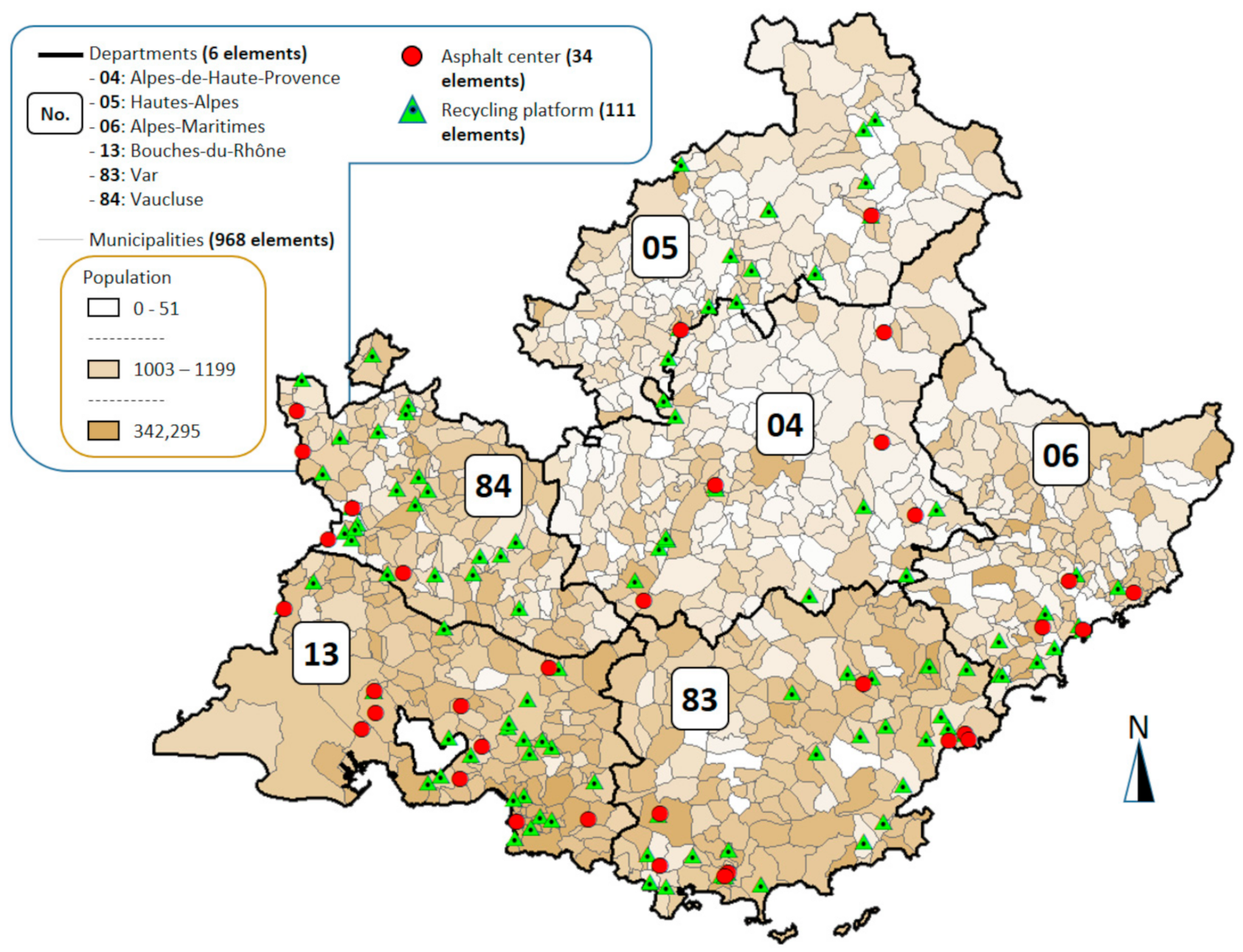


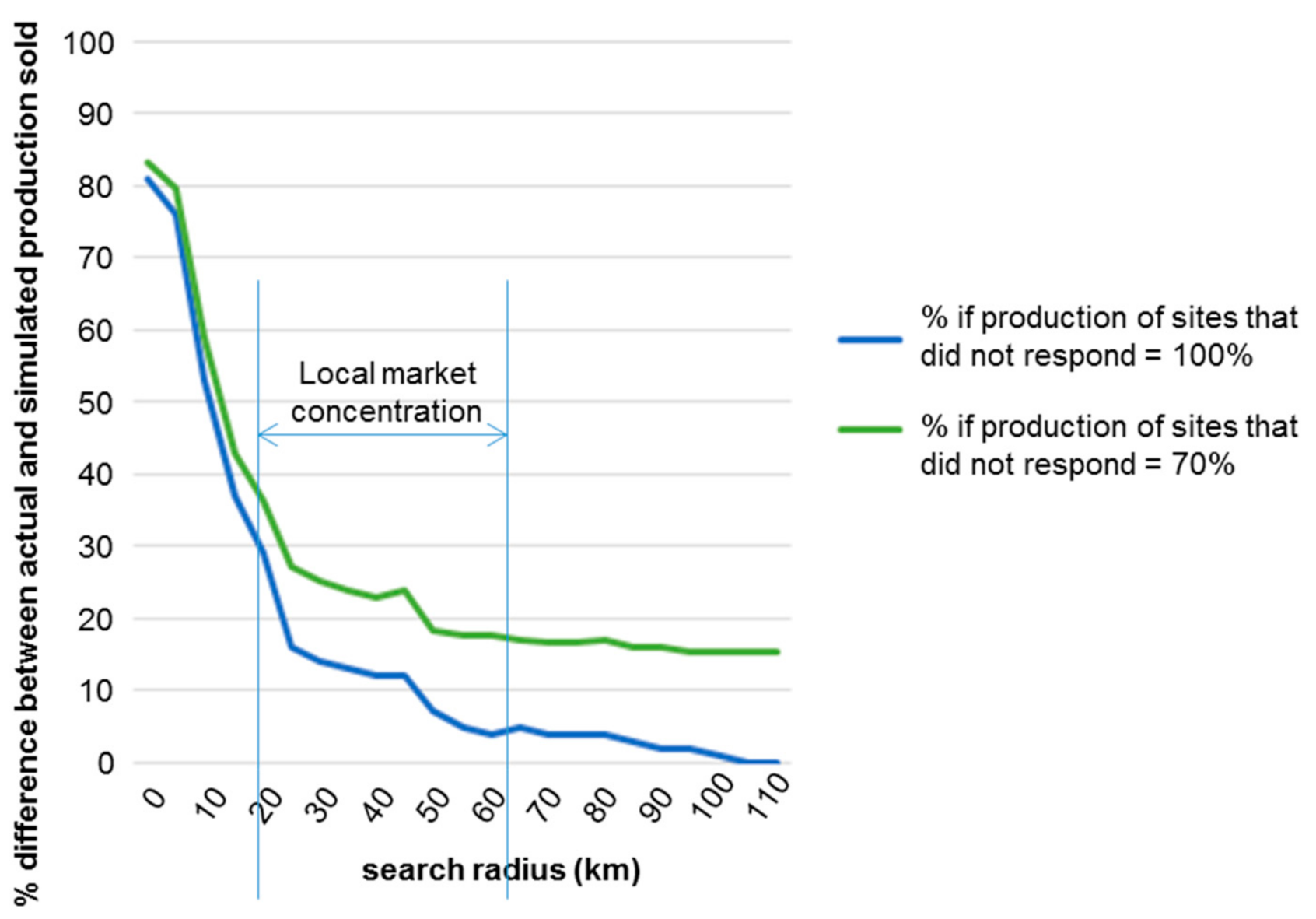

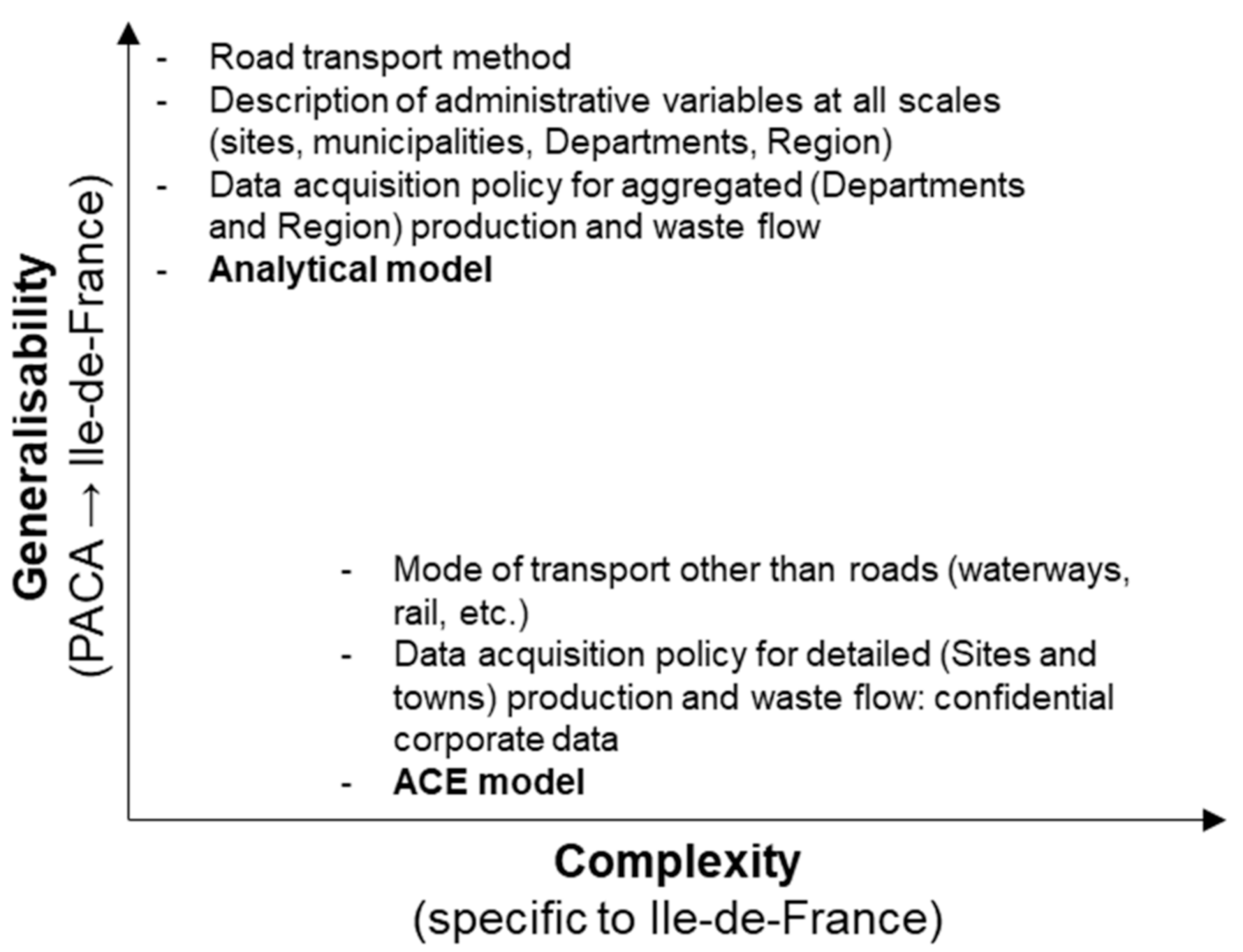
| Material Production | Value (Mt) |
|---|---|
| Gravel production | 1,393,579 |
| Asphalt production | 2,508,694 |
| Column | A | B | C | D | E |
|---|---|---|---|---|---|
| Municipality (M) | Road total length (km) | Length to renovate (km) | Renovation rate (%) based on data (=B/A * 100) | Length to renovate (km) after normalization (=A * 3.7%) | Difference (%) between length from data and calculated values (=B/D * 100) |
| Data | Calculus | ||||
| M1 | 15 | 2.5 | 16.6 | 0.55 | 452 |
| M2 | 120 | 2.5 | 2.1 | 4.44 | 56 |
| Zone M1 + M2 | 135 | 5 | 3.7 | ||
| Subject (Agent) | Decision Scales | Objectives | Object or Subject of the Decision |
|---|---|---|---|
| Recycler (waste consumer) | Sites | Transform the maximum amount of waste into “gravel” materials (stored and intended for sale) | Waste |
| Municipalities | Sell maximum amount of gravel | Stored gravel | |
| Asphalt producer (waste consumer) | Municipalities | Sell maximum amount of asphalt | Stored asphalt |
| Project manager (PM) | Municipalities | Conduct roadwork (here road renovation) | French Roads of different types:
|
| Sites | Identify the appropriate quantity of materials for renovation | Gravel and asphalt | |
| Minimise the cost of transport from the supplier | Recycler and asphalt producer |
| From Municipality Capital… | To Municipality Capital | Minimum Distance (in km) |
|---|---|---|
| (…) | (…) | (…) |
| Braux (04032) | Lamotte-Du-Rhone (84063) | 229.47 |
| Braux (04032) | Lapalud (84064) | 231.75 |
| Braux (04032) | Saintes-Maries-De-The-Mer (13096) | 246.80 |
| Montclar (04126) | Selonnet (04203) | 3.93 |
| Montclar (04126) | Seyne (04205) | 7.74 |
| Montclar (04126) | Saint-Vincent-Les-Forts (04198) | 7.96 |
| Montclar (04126) | Saint-Martin-Les-Seyne (04191) | 8.55 |
| Montclar (04126) | Le Lauzet-Ubaye (04102) | 13.57 |
| Montclar (04126) | La Breole (04033) | 14.96 |
| Montclar (04126) | Le Vernet (04237) | 18.07 |
| Montclar (04126) | Rousset (05127) | 20.66 |
| Montclar (04126) | Espinasses (05050) | 21.35 |
| Montclar (04126) | Meolans-Revel (04161) | 21.66 |
| Montclar (04126) | Le Sauze-Du-Lac (05163) | 21.79 |
| Montclar (04126) | Verdaches (04235) | 21.92 |
| Montclar (04126) | Auzet (04017) | 23.92 |
| Montclar (04126) | Theus (05171) | 24.90 |
| Montclar (04126) | Remollon (05115) | 26.18 |
| (…) | (…) | (…) |
Publisher’s Note: MDPI stays neutral with regard to jurisdictional claims in published maps and institutional affiliations. |
© 2021 by the authors. Licensee MDPI, Basel, Switzerland. This article is an open access article distributed under the terms and conditions of the Creative Commons Attribution (CC BY) license (https://creativecommons.org/licenses/by/4.0/).
Share and Cite
Andriamasinoro, F.; Monfort-Climent, D. Consideration of Complexity in the Management of Construction and Demolition Waste Flow in French Regions: An Agent-Based Computational Economics Approach. Modelling 2021, 2, 385-405. https://doi.org/10.3390/modelling2030021
Andriamasinoro F, Monfort-Climent D. Consideration of Complexity in the Management of Construction and Demolition Waste Flow in French Regions: An Agent-Based Computational Economics Approach. Modelling. 2021; 2(3):385-405. https://doi.org/10.3390/modelling2030021
Chicago/Turabian StyleAndriamasinoro, Fenintsoa, and Daniel Monfort-Climent. 2021. "Consideration of Complexity in the Management of Construction and Demolition Waste Flow in French Regions: An Agent-Based Computational Economics Approach" Modelling 2, no. 3: 385-405. https://doi.org/10.3390/modelling2030021
APA StyleAndriamasinoro, F., & Monfort-Climent, D. (2021). Consideration of Complexity in the Management of Construction and Demolition Waste Flow in French Regions: An Agent-Based Computational Economics Approach. Modelling, 2(3), 385-405. https://doi.org/10.3390/modelling2030021






